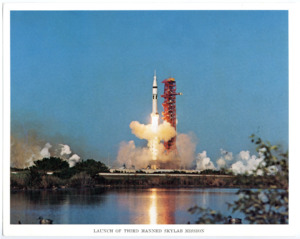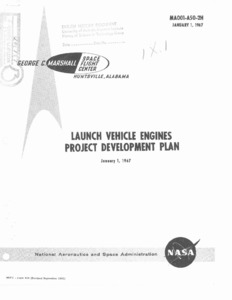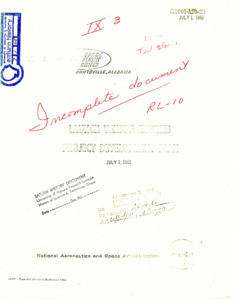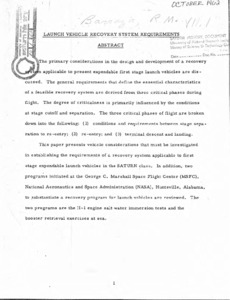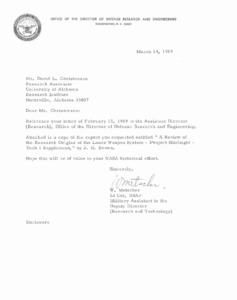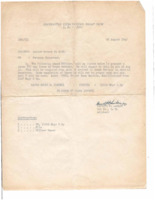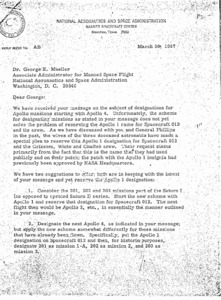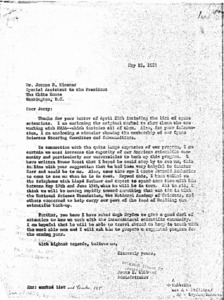
Browse Items (8218 total)
Sort by:
-
"Launch Vehicle Engines Project Development Plan."
This revised edition of the Launch Vehicle Engines Project Development Plan supersedes the issue dated July 1, 1965. Significant changes which have been made are:- Removal of classified data to permit publication as an unclassified document; - Removal of material applicable to the RL-10 Engine Project which was transferred to the Lewis Research Center effective May 1, 1966; - Elimination of detailed schedules which quickly become obsolete; - Punched for maintenance in loose-leaf 3-ring binders and for ease in updating material through issuance of replacement sheets. Binders are not furnished. The information in this document is current to January 1, 1967.; The Launch Vehicle Engines Project Development Plan is established in accordance with requirements of NASA General Management Instruction 4-1-1, Planning and Implementation of NASA Projects, and OMSF Instruction MP 9320.044, Preparation and Revision of Program/Project Development Plans (PDP's). The Plan, herein referred to as the PDP, has been developed within the scope of current Apollo Projects Approval Documents (PADS) and will be maintained by the Engine Program Manager to identify program requirements, responsibilities, tasks, and resources, and time phasing of major actions required to accomplish the Engine Program. -
"Launch Vehicle Engines Project Development Plan."
The primary mission objective of the 5-2 Engine Project is to continue development of a liquid oxygen/liquid hydrogen engine. capable of high-altitude restart. Both Saturn IB and Saturn V vehicles will use the J-2 engine; the S-IVB stage of Saturn IB vehicles and S-IVB stage of Saturn V vehicles will be equipped with a single J-2 engine. The S-I1 stage of Saturn V vehicles will use a cluster of five J-2 engines. Figure 1-3 illustrates these stages. -
"Launch Vehicle Recovery System Requirements."
The primary considerations in the design and development of a recovery system applicable to present expendable first stage launch vehicles are discussed. The general requirements that define the essential characteristics of a feasible recovery system are derived from three critical phases during flight. The degree of criticalness is primarily influenced by the conditions at stage cutoff and separation. The three critical phses of flight are broken down into the following: (1) conditions and requirements between stage separation to re-entry; (2) re-entry; and (3) terminal descent and landing. -
"Lethal Weapons Too; Classifed Information, Even on a Fragile Disk, Is Deadly in Wrong Hands.; Safeguard it!"
Lethal weapons and classified documents -
"Lethal Weapons Too; Classified Information Even In This Fragile Form, Is Deadly In the Wrong Hands. Safegaurd It."
Lethal weapons and classified documents -
"Letter from Mr. David L. Christensen."
Letter stating that "A review of the research origins of the Lance weapon system - Project Hindsight -Task 1 supplement" is inside as requested. -
"Letter Orders No 8-20".
The orders grant Edwin D. Burwell Jr. seven days of leave to Great Britain. -
"Letter to Dr. George E. Mueller."
This letter regarding designations for Apollo missions notes that "Unfortunately, the scheme for designating missions as stated in your message does not yet solve the problem of reserving the Apollo 1 name for Spacecraft 012 and its crew. As we have discussed with you and General Phillips in the past, the wives of the three deceased astronauts have made a special plea to reserve this Apollo 1 designation for Spacecraft 012 and the Grissom, White and Chaffee crew."; Archive copy is a photocopy.; In replay refer to: AB. -
"Letter to Dr. Jerome B. Wiesner."
Letter to Jerome B. Wiesner from Jones B. Webb regarding requested documents as well as how they, as scientists, interact with the scientific community.
